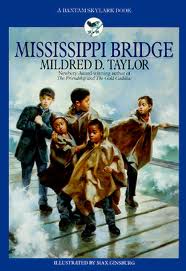 Mississippi Bridge
Mississippi Bridge is an illustrated novella rather than a novel, but the slim size and pictures shouldn’t lull you into thinking it’s a sweet book for young kids. It’s a powerful picture of racism in 1931 Mississippi, told from the point of view of a ten year old white boy.
Jeremy, our narrator, spends a rainy afternoon on the porch of the local general store and watches as people arrive to catch the weekly bus to Jackson. He witnesses many acts of casual and overt racism, made all the more painful because his father is among the racists and the younger blacks are among those he considers peers and friends.
When tragedy strikes, it only makes the situation that much more incomprehensible to Jeremy.
SPOILER ALERT: Things you might want to know before suggesting this to your kid
Racism
A snapshot of racism is pretty much the point of the book. It’s not an easy read. The N word is used several times by Jeremy’s father and the other white men hanging around the store. The store clerk won’t allow a young black girl to try on a hat, and if she did buy it she couldn’t return it once it was on her head. Clearly, putting it on her head would irreparably contaminate it. He doesn’t have the same compunction with a white woman, encouraging her to try on the hat while the black girl watches.
Josias, a young black man, is catching the bus to get to a job that will pay cash money. The poor white men accuse him of lying—if they don’t have jobs that pay cash money, how could he possibly get one? No one who is black should ever have anything more than a white person has. Eventually, Josias does lie to them, telling them he’s actually going to help a sick cousin with the planting. Jeremy calls him on this in private, and Josias says he couldn’t risk the beating that would come if he stood up to the men.
Several black passengers are thrown off the bus when white customers show up. It doesn’t matter that they’re going for a job, to help a sick relative, or whatever. White people just matter more, so they lose their seats and will have to wait another week until the next bus comes. If they were allowed on the bus, they would have had to sit in the back.
These are just a few of the examples. There are many more along these lines.
Family
Jeremy is afraid of his father—he doesn’t really blame Josias for not wanting to get on his father’s bad side any more than necessary. When Jeremy’s father realizes his son has been talking to black people, he cuffs him upside the head. Yet Jeremy still knows he needs to respect his father. He doesn’t seem quite sure what to do with his father’s racism which seems so obviously wrong to Jeremy.
Family is a bit fluid—grandmothers care for their grandchildren, older siblings look out for the younger ones.
Tragedy, Death, and God
After all of the black people are kicked off the bus, the bus skids out on a rickety bridge and goes into the rain-swollen river. Two of the kind white people drown—Jeremy’s former teacher and her five year old granddaughter. Josias pulls their bodies from the river. Together, Josias and Jeremy spend the rest of the day pulling people out of the river. Jeremy asks Josias why it happened, why Mizz Hattie and little Grace Anne died. Why Josias and the others were spared by the evil of being kicked off the bus. The best Josias has to offer is that God works in mysterious ways. That’s little consolation to Jeremy.
Sexism
After days of rain, Jeremy notes that the women still have plenty of work to do. But the menfolk have mended all the tools and fences, so all they can do it wait for the rain to stop. That’s why he and his father are hanging out at the general store.
Dialect and Language
As mentioned above, the N word is used several times by white men to refer to black people. Stereotypes and insults are rampant.
Told in Jeremy’s voice, the dialect is strong. This is part of why this book isn’t really suitable for younger readers—sounding every word out will likely be frustrating. It’s easy enough to follow if you process it in chunks (as more experienced readers do) instead of word by word (as beginning readers do).
Recommendation
It’ll take you an afternoon to read this—possibly as long as it takes for the action in the book to occur—and it’s totally worth the time. It’s thought provoking and insightful and tragic. Yes, the death is a bit arbitrary, but that’s part of the point in this novella.
Mississippi Bridge by Mildred D. Taylor
Illustrated by Max Ginsburg
Published in 1990 by Skylark Books
Read my personal copy





Speak Your Mind